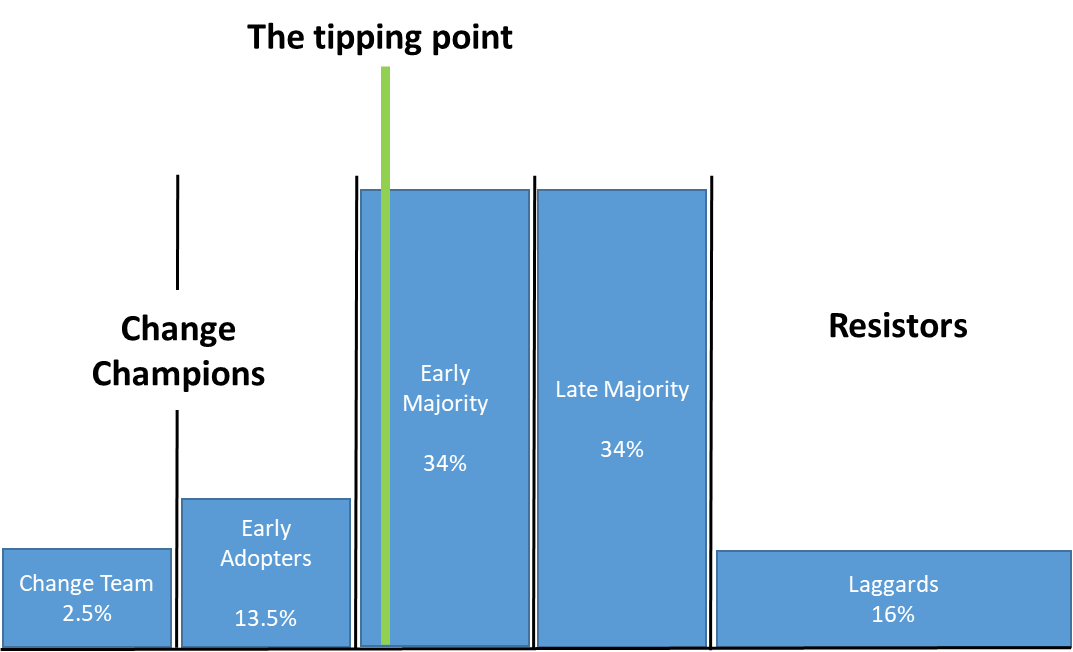Manage the People Introduction
People's response to change
When a company transitions, the people who work there are also required to transition. Managing people during this time can be challenging. The goal is to manage people during the transition successfully. Successful management takes employees through the journey of change, from being sceptical about the change to accepting the change and, finally, being excited by the change.
When it comes to managing people, every individual's response to change will be different; however, at a high level, they can be defined by these four categories:
● Adopter
● Bystander
● Resistor
● Casualty

The goal of the Manage the People function aims to find and manage the people who believe in and are committed to the transformation. These people advocate for the initiative ideas, helping them be more contagious. People are the company's most valuable asset. They will determine if the transformation programme succeeds.
Managing the people categories
The first of these is the Early Adopters, often people with ownership and expertise in the area(s) most affected by the change. It is crucial to support them by providing tools and information to engage, publicly recognising & rewarding their efforts and successes.
The next most important and often most significant group is the
Bystanders. They are usually split in their support and involvement in the Change Initiative. This can be articulated in a classic bell curve and the Law of Diffusion.

Every project will have Resistors who actively (or passively) oppose or block the change. Resistors can come from any level in an organisation, and their influence should not be underestimated. An equally critical part of the manage the people function is identifying and managing the resistors as they can have the opposite effect, generate negative impacts, and oppose adoption.
The fourth category, which only sometimes transpires and sometimes overlaps with resistors, is the Casualties. These are employees in roles which will likely not survive the change. This process is challenging and necessary and should be managed and communicated early.
List of Services
-
Early AdoptersGo to the article List Item 1
The early adopters are the people who believe in and are committed to the transformation. They advocate for the initial ideas, helping them be more contagious. Once you get enough of the 15 - 18% on the left side of the tipping point, they will encourage the rest to follow. Identify and engage your early adopters and early majority as Change Champions as they can have a dramatic impact on the adoption and momentum of your transformation programme.
-
BystandersGo to the article List Item 2
The bystanders are the majority of the people who need to embrace the change to ensure a successful transformation. The bystanders are those affected by the programme who are not invested in the initiative and may or may not be resistant to it. Initially, their behaviour is passive and they are neither helping nor hindering the transformation process.
-
ResistorsGo to the article List Item 3
It is critical to identify and manage the resistors as they can have the opposite effect, generate negative impacts and opposition to adoption. Resistors can come from any level in an organisation and their influence should not be underestimated. It is important to engage with resistors allowing them to understand the requirement for change.
-
CasualtiesGo to the article List Item 4
The forth category which don't always transpire and sometimes overlaps with resistors are the Casualties. These are employees in roles which will likely not survive the change. Casualties are different from resistors in that they may be willing to change but their role is no longer relevant. This is a difficult but necessary process and should be managed and communicated early on.
Compose the Change
Browse by Categories

Free On-Line Change Management Methodology that enables individuals and organisations, especially those previously without access to effective change management programmes, to deliver more effective community and country programmes which improve prosperity and save lives.
QUICKLINKS
TRAINING LINKS
LATEST POSTS




